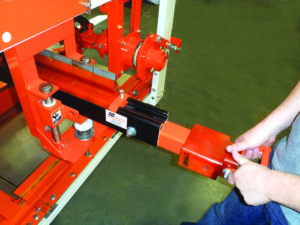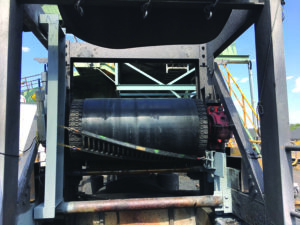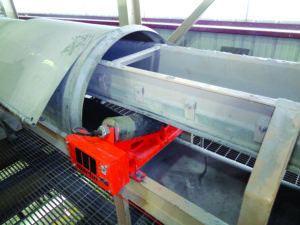Conveyors are among the most dynamic and potentially dangerous areas of equipment at a mine. Even though their safety and performance are critical to the operation’s success, the impact of their contribution to overall efficiency is often unrecognized by management and workers alike. Operational basics of belt conveyor systems are too often a mystery to those employees, who have little understanding about the hardware installed and the performance required from the components.
The knowledge gap is understandable. The attention of personnel at a mine or coal handling operation is centered on the processing of the company’s main product. The “care and feeding” of belt conveyors — the adjustment, maintenance and troubleshooting that make a huge difference in safety, performance and profitability — is typically outside of their expertise. It’s not that they don’t care about conveyors, but the ongoing maintenance and service of them is often not part of their immediate focus or within their time constraints.
Protecting the Most Valuable Assets: People

This slide-out belt cleaner is engineered to be accessed safely and replaced by a single worker.
“Personnel are the single most important resource of any mine or industrial operation, and engineers and designers are incorporating greater functionality into designs that will improve safety,” observed Martin Engineering Chief Technology Officer Paul Harrison. “Standards continue to tighten, and MSHA retains a strong focus on worker safety, driving the need for equipment designs that are not just safe, but optimized for safety. That is, designed with safety as a fundamental priority. At the same time, there is increasing pressure for continuous and ever-increasing production.”
To meet the demands for greater safety and improved production, some manufacturers have introduced equipment designs that are not only engineered for safer operation and servicing, but also reduced maintenance time. One example is a new family of heavy-duty conveyor belt cleaners, designed so the blade cartridge can be pulled away from the belt for safe access and replaced by a single worker.
The same slide-out technology has been applied to impact cradle designs. The systems are engineered so operators can work on the equipment safely, without breaking the plane of motion. “External servicing reduces confined space entry and eliminates reach-in maintenance, while facilitating faster replacement,” Harrison said. “The result is greater safety and efficiency, with less downtime.”
Another example is a revolutionary new belt cleaner design that can reduce the need for bulky urethane blades altogether, an innovative belt cleaning system that has received the Australian Bulk Handling Award in the “Innovative Technology” category for its design and potential benefits. The patented design delivers extended service life, low belt wear, significantly reduced maintenance and improved safety, ultimately delivering lower cost of ownership.

The track-mounted systems can be serviced quickly and safely, with no reach-in maintenance.
“Unlike conventional belt cleaners that are mounted at an angle to the belt, this unique cleaner is installed diagonally across the discharge pulley, forming a 3D curve beneath the discharge area that conforms to the pulley’s shape,” Conveyor Products Manager Dave Mueller said. “The design incorporates a matrix of tungsten carbide scrapers and is tensioned lightly against the belt to prevent damage to the belt or splices.”
Despite extremely low contact pressure between belt and cleaner, it has been shown to remove as much as 95% of potential carryback material. The novel approach has been so effective that in many operations, previously crucial secondary-belt cleaners have become unnecessary, saving further on belt cleaning costs and service time.
Providing Power
Another trend in large operations is a need for enhanced automation and monitoring, including such tasks as load sensing, belt tracking, cleaner tensioning and lighting. “In most cases, electrical power is supplied only to the conveyor locations where it’s needed, such as the drive motor, and is not typically available for general purpose use,” Harrison continued. “In many operations, this lack of available power means that any monitoring of the conveyor must be done by technicians physically walking the length of the structure, which can be a difficult and time-consuming task when the systems are long and span difficult terrain.”
A more efficient approach is to employ sensors to transmit important data from remote points to a central location where it can be monitored in real time and recorded for later analysis. But intelligent monitoring systems for any conveyor system require power for extended operation. Due to the distances involved, cabled communication systems are not ideal, and therefore wireless communication systems are more advantageous. Options such as solar are not well suited to the general conditions of a conveyor system, as monitoring devices are often required in an enclosed structure without access to sunlight, or for continuous operation during both day and night.

The unique belt cleaner forms a 3D curve beneath the discharge that conforms to the pulley’s shape.
A conveyor is driven by a multikilowatt motor, and this power is readily available system-wide in the form of the moving belt. The motors driving the belts are typically sized with a considerable power safety factor to account for parasitic loads. For these reasons, engineers have searched for ways to take advantage of the available kinetic energy of the moving belt to bring power to the specific places where sensors and other devices would provide advantages.
Product engineers developed a method to generate power from the conveyor through the use of a magnetic coupling that attaches to the end of an existing roller. “The outside diameter of the generator matches the diameter of the roll, but places the generator outside the normal belt line to avoid the heavy loads and fugitive material that tends to damage existing design attempts,” Mueller added. “The generator is held in a fixed position by the roll support system, but is not normally required to bear any of the material load.”
The reliable power supply helps bring a new level of sophistication to conveyors, allowing designers to equip their systems with devices such as weigh scales, proximity switches, moisture sensors, pressure switches, solenoids and relays, as well as timers, lights and even additional safety mechanisms. Wireless communication can be used to transmit directly to a central controller, giving operators a cost-effective way to access data that has not been readily available in the past — and taking another step toward “smarter” conveyor systems.

The generator can be employed on virtually any steel roller.
In a related move toward safer, more productive material handling, one global conveyor technology innovator has introduced an automated pneumatic tensioning system for belt cleaners. The new device delivers precise monitoring and tensioning throughout all stages of blade life, minimizing the labor typically required to maintain optimum blade pressure and extending the service life of both the belt and the cleaner. Equipped with sensors to confirm that the belt is loaded and running, the system automatically backs the blade away during stoppages or when the conveyor is running empty, minimizing unnecessary wear to both the belt and cleaner. The result is consistently correct blade tension, with reduced power demand on startup, all managed without human intervention.
With a properly trained staff and thoughtfully designed components, conveyor maintenance is becoming easier and safer than ever before. Thanks to new component designs and advanced engineering capabilities, the work environment has been drastically improved in recent years, and operators are reducing downtime due to cleanup and broken equipment. These gains should inspire operators to make time for a cost/benefit analysis of new technologies and assess the long-term gains of both increased efficiency and workplace safety.
This article was written and submitted by Martin Engineering.




